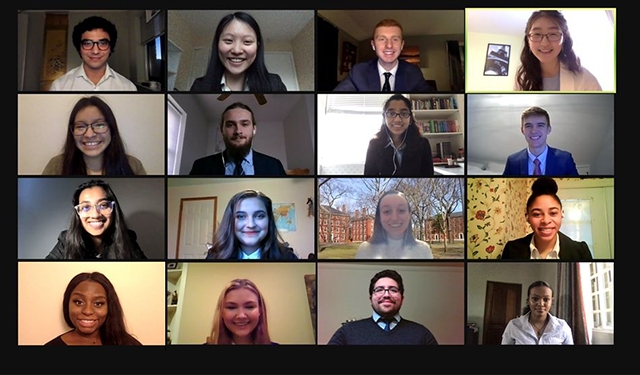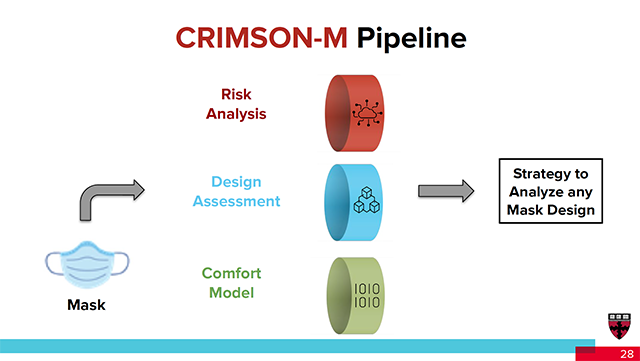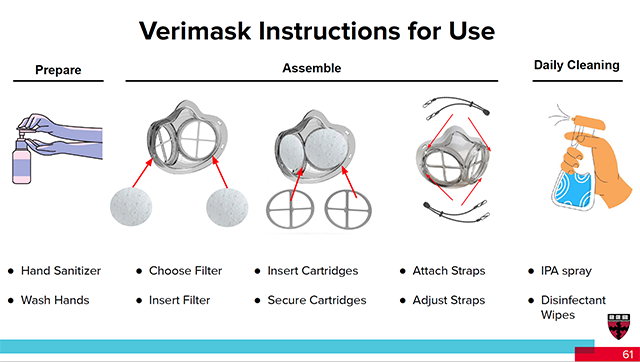News
Students in ES 96 collaborated to develop a COVID-19 infection risk analysis tool to evaluate face masks.
Mandatory mask use on the Harvard campus has been a major factor in limiting the spread of COVID-19. During the fall semester, the University reported only a 0.12 percent positivity rate on campus, and a rate of only 0.05 percent among undergraduates.
The science is clear and the numbers don’t lie—masks work, but not all masks are created equal.
For their project in Engineering Problem Solving and Design Project (ES 96), a group of John A. Paulson School of Engineering and Applied Sciences students worked with the Harvard University Face Masks Committee to explore the effectiveness of different masks. The students created a framework the committee could use to analyze any mask, assessing its design, comfort, and ability to limit the spread of the disease in different campus settings.
To develop a model for the mask wearer’s probability of infection, the students explored the specifications of different campus spaces, including classrooms, dorm rooms, and dining halls. They considered factors including the amount of time students spend in those spaces, air exchange, and the filtration efficiency of masks.
For instance, they found that if all students in a large lecture hall sat at least six feet apart and wore masks with a filtration efficiency of at least 85 percent, the likelihood of infection is less than 1 percent during a 90-minute class. With those guidelines in place, Science Center Hall B could safely accommodate 54 students—less than its 492-person capacity, but nearly double the 28 students who could safely attend class wearing common procedural face masks, which have only ~65 percent filtration efficiency.
The students created a framework the Harvard University Face Masks Committee could use to analyze any mask, assessing its design, comfort, and ability to limit the spread of the disease in different campus setting.
The students conducted similar risk analyses for meal pickups in dining halls and the use of shared bathrooms in dorm buildings (a mask with 70 percent filtration efficiency keeps the risk of infection below 1 percent in both situations).
Building off those analyses, they developed a website that outputs the probability of infection in a given campus location and situation. The team then took their risk analysis framework one step further and used it to design a mask that could meet filtration efficiency requirements for dorm rooms, dining halls, and classrooms.
They paid special attention to design parameters that would maximize comfort, and developed a model that incorporates air resistance, water vapor permeability, and facial temperature change.
“Comfort is a big part of user compliance,” said project co-lead Emily He, S.B. ’22, an engineering sciences concentrator. “If it is not comfortable, students are not going to wear them, and that defeats the purpose of having a mask in the first place. There has never been a quantitative model for mask comfort before.”
They studied comfort, filter efficiency, and material specifications when creating the Verimask, which allows for changeable filters so it could be re-used and worn in settings requiring either 70-percent or 85-percent filtration efficiency.
One of the biggest challenges the team faced was designing and testing their prototype, since only three team members were on campus and able to work on the physical device, said project co-lead Esther Koh, S.B. ’22, an engineering sciences concentrator. Because of those challenges, the team reached out to contacts at different companies for help with testing. For instance, individuals at 3M conducted pressure drop tests of the Verimask, He said.
The students also prototyped the Verimask, which allows for changeable filters and could be used in different campus settings.
The team used their risk analysis framework to compare the Verimask prototype’s performance to three other common designs. While the prototype did not meet all the specifications, the students were able to show how their risk analysis tool could be used to evaluate and compare masks.
“This project has really emphasized to me that design is an iterative process,” Koh said. “So many changes have occurred throughout this project. It has been challenging to keep everyone engaged in our virtual environment, but we’ve learned a lot about how to foster community, even in a project that is being done remotely.”
Despite the challenges, instructor David Mooney, Robert P. Pinkas Family Professor of Bioengineering, was impressed by the work the students did this term.
“The students established a very ambitious goal for the semester, and through their creativity and teamwork developed a very thorough process to evaluate face masks for their ability to enable greater in-person teaching and learning on campus,” he said.
Stephen Blacklow, Gustavus Adolphus Pfeiffer Professor of Biological Chemistry and Molecular Pharmacology and chair of the Harvard Face Masks Committee, agreed.
“Effective mask policy is central to the University’s risk mitigation strategy to combat transmission of SARS-CoV-2. The ES 96 students did an outstanding job quantifying the importance of key variables, including filtration efficiency, fit, and compliance in quantitative models that they developed to predict mask effectiveness,” he said. “They also proposed a mask solution that has the potential to enable increased on-campus activity and certain low-density in-person classes if fully implemented.”
Cutting-edge science delivered direct to your inbox.
Join the Harvard SEAS mailing list.
Press Contact
Adam Zewe | 617-496-5878 | azewe@seas.harvard.edu





